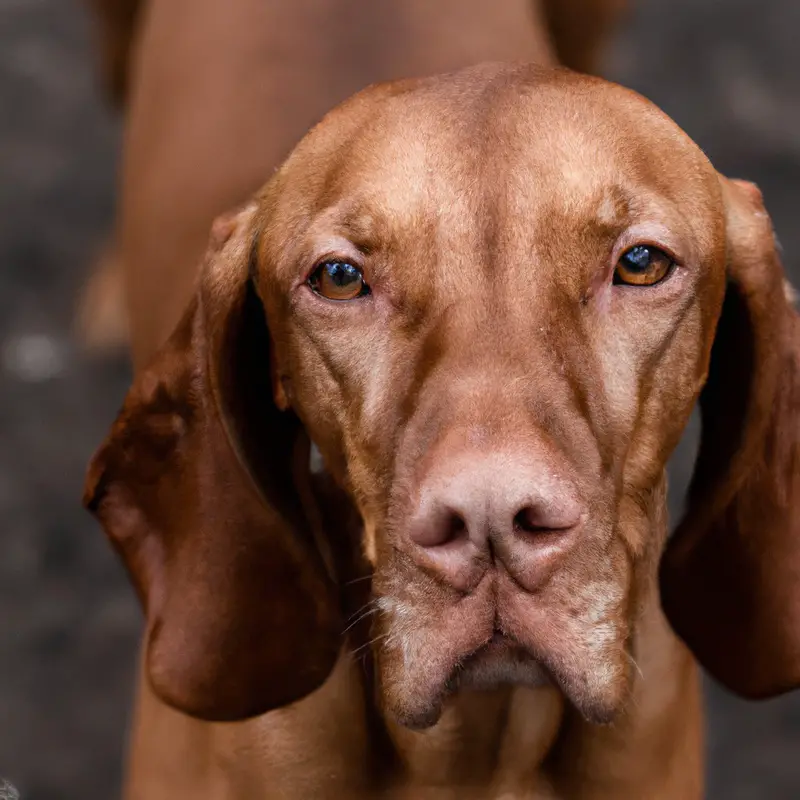What Are Some Potential Signs Of Vizsla Allergies And How To Manage Them?
Key Takeaways:
- Potential signs of Vizsla allergies include excessive itching, sneezing, and skin irritation.
- Managing Vizsla allergies involves identifying and avoiding triggers, such as certain foods or environmental factors.
- Regular grooming, using hypoallergenic products, and seeking veterinary guidance can help alleviate Vizsla allergies.
- Allergy testing and immunotherapy may be necessary for severe cases of Vizsla allergies.
Are you a proud Vizsla owner noticing some unusual behaviors or symptoms in your furry friend?
Well, it’s time to dig deep into the world of Vizsla allergies.
These common and pesky allergies can manifest in various ways, from skin irritations to digestive issues, affecting your pup’s quality of life.
But fear not! As an expert in Vizsla care, let me guide you through the signs of allergies to watch out for and effective management strategies.
We will explore everything from diagnosing allergies with your vet to home remedies and preventive measures.
So, let’s embark on this journey to ensure your Vizsla stays healthy and happy!
| Signs of Vizsla Allergies | Management Tips |
| Skin itching and irritation | Regularly bathe and groom your Vizsla, use hypoallergenic shampoos, and consult with a veterinarian for medication or allergy shots if necessary. |
| Red and watery eyes | Keep the environment clean, limit exposure to potential allergens, and consult with a veterinarian for eye drops or medications. |
| Constant sneezing and coughing | Avoid exposure to airborne allergens, use air purifiers, and consult with a veterinarian for antihistamines or other medication. |
| Ear infections and frequent head shaking | Clean and dry the ears regularly, prevent moisture buildup, and consult with a veterinarian for ear drops or other medication. |
| Vomiting or diarrhea | Identify and avoid potential food allergens, try hypoallergenic diets, and consult with a veterinarian for further investigation and management. |
| Excessive paw licking or chewing | Keep the paws clean and dry, consider using booties or protective balms, and consult with a veterinarian for medication or allergy testing. |
| Hair loss or hot spots | Regularly groom your Vizsla, keep the skin clean and dry, and consult with a veterinarian for possible treatments or medication. |
Common signs of Vizsla allergies
Skin-related symptoms
Skin-related symptoms in Vizslas are often indicators of allergies. These symptoms can include redness, itchiness, hives, and hair loss.
You might also notice your Vizsla scratching, licking, or chewing their skin excessively.
To manage these symptoms, it’s important to identify the allergen causing the reaction. This might involve removing certain foods or environmental triggers from your Vizsla’s routine.
Regular grooming, using hypoallergenic products, and consulting with a veterinarian can help alleviate their discomfort.

Respiratory symptoms
Respiratory symptoms in Vizslas can be a sign of allergies.
Some common respiratory symptoms include sneezing, coughing, wheezing, and difficulty breathing.
If you notice any of these symptoms in your Vizsla, it’s important to consult with your veterinarian for proper diagnosis and treatment.
Managing respiratory symptoms may involve avoiding allergens, keeping your Vizsla’s environment clean, and potentially using medication prescribed by your vet.
Regular check-ups and open communication with your vet are key in ensuring your Vizsla’s respiratory health.

Digestive symptoms
Digestive symptoms in Vizslas can indicate allergies. These symptoms may include diarrhea, vomiting, gas, bloating, and stomach discomfort.
It’s important to pay attention to your Vizsla’s bowel movements and any changes in their eating patterns.
If you suspect allergies, consult with your vet to determine the best course of action. They may recommend a dietary change or allergy testing to pinpoint the specific allergen affecting your dog.
Taking steps to manage these digestive symptoms can help keep your Vizsla healthy and comfortable.

Behavioral symptoms
Vizslas with allergies may exhibit certain behavioral symptoms. These can include excessive scratching, licking or biting of their skin, as well as rubbing their face or body against furniture or the floor.
They may also become irritable or display signs of anxiety, such as restlessness or frequent pacing.
Some Vizslas with allergies may also experience changes in appetite or sleep patterns. If you notice any of these behavioral symptoms in your Vizsla, it’s important to consult with your veterinarian for a proper diagnosis and to discuss potential management strategies.
Diagnosing Vizsla allergies
Visiting a veterinarian
Visiting a veterinarian is important if you suspect your Vizsla may have allergies. A vet can accurately diagnose the problem, provide treatment options, and offer advice on managing the allergies.
During the visit, be prepared to discuss your Vizsla’s symptoms, any changes in their environment or diet, and any previous treatments attempted.
The vet may conduct tests or recommend a specialized diet to identify allergens. Trusting a veterinarian’s expertise is crucial in ensuring your Vizsla’s health and managing their allergies effectively.
Evaluation of medical history and symptoms
Evaluation of medical history and symptoms is a key step in diagnosing Vizsla allergies. By examining your Vizsla’s medical history, including any previous allergies or symptoms, a veterinarian can gain important insights.
They will also ask about your Vizsla’s current symptoms, such as itching, redness, or gastrointestinal issues.
It’s important to provide detailed information to ensure an accurate diagnosis. Additionally, your vet may conduct further tests, such as skin or blood tests, to confirm the presence of allergies.
Allergy testing options
When it comes to allergy testing options for your Vizsla, there are a few approaches you can consider.
One option is a blood test, which can identify specific allergens that your dog may be reacting to.
Another option is a skin test, where a small amount of allergens are applied to the skin and any reactions are observed.
Additionally, an elimination diet may be recommended to determine if certain foods are causing allergic reactions.
It’s best to consult with your veterinarian to determine the most appropriate testing method for your Vizsla.
Managing Vizsla allergies
Avoidance of allergens
Avoidance of allergens is key in managing Vizsla allergies.
Here are some tips to help you keep your Vizsla away from potential triggers:
- Keep your home clean and free of dust, pollen, and other common allergens.
- Use hypoallergenic bedding and wash it regularly to minimize exposure to allergens.
- Avoid outdoor activities during peak pollen times and limit exposure to grassy areas.
- Consider using air purifiers or filters to remove allergens from the air in your home.
- Be mindful of the ingredients in your Vizsla’s food and choose hypoallergenic alternatives if necessary.
- Regularly groom your Vizsla to keep their coat clean and minimize allergen buildup.
Remember, avoiding allergens is an important step in managing Vizsla allergies and keeping your furry friend comfortable and healthy.
Medications for allergy relief
Medications for allergy relief can help alleviate symptoms and improve your Vizsla’s comfort. Antihistamines are commonly prescribed and work by blocking histamine, the chemical responsible for allergic reactions.
Steroids may be recommended for severe allergies, as they reduce inflammation.
Immunotherapy, or allergy shots, are another option for long-term relief by gradually desensitizing your Vizsla’s immune system. When using any medication, consult your vet for proper dosage and potential side effects.
It’s important to follow their guidance to ensure the health and well-being of your furry friend.
Allergy shots or immunotherapy
Allergy shots, also known as immunotherapy, can be an effective treatment for Vizsla allergies.
This treatment involves receiving regular injections of allergens to help desensitize the Vizsla’s immune system.
Over time, this can reduce or even eliminate allergic reactions.
Allergy shots are typically administered by a veterinarian and require multiple sessions over a period of several months.
It’s important to follow the treatment plan consistently and as directed by your vet to see the best results.
Adaptations to dietary needs
When it comes to adapting to dietary needs for Vizslas, there are a few key factors to consider.
Firstly, it’s important to provide a high-quality, balanced diet that meets their nutritional requirements.
This means choosing a dog food that contains real meat as the first ingredient, rather than fillers or by-products.
Additionally, Vizslas may benefit from a grain-free diet due to potential sensitivities.
Secondly, portion control is crucial to prevent overeating and maintain a healthy weight.
Be sure to follow the recommended feeding guidelines provided by the food manufacturer and consult with your veterinarian if you have any concerns.
Thirdly, some Vizslas may have specific dietary restrictions or sensitivities.
If your dog exhibits signs of allergies or intolerances, such as itching, gastrointestinal issues, or excessive shedding, you may need to explore a limited ingredient diet or work with your vet to identify potential allergens and eliminate them from their diet.
Remember to always provide fresh water and consult with your veterinarian for personalized dietary recommendations based on your Vizsla’s specific needs.
Home remedies and prevention
Bathing and grooming techniques
When it comes to bathing and grooming your Vizsla, here are some techniques you can use to keep them looking and feeling their best:
- Brushing: Regular brushing helps to remove loose hair and prevent matting. Use a brush or a grooming glove to gently brush your Vizsla’s coat.
- Bathing: Bathe your Vizsla only when necessary, as frequent bathing can strip their coat of essential oils. Use a dog-specific shampoo and make sure to rinse thoroughly to avoid skin irritation.
- Ear Care: Check and clean your Vizsla’s ears regularly to prevent ear infections. Use a dog ear cleaner solution and gently wipe the outer part of their ears with a soft cloth or cotton ball.
- Nail Trimming: Keep your Vizsla’s nails short to avoid discomfort and potential injury. Use a dog nail clipper or grinder and trim the nails carefully, avoiding the quick.
- Dental Care: Brush your Vizsla’s teeth regularly to prevent dental issues. Use a dog-specific toothpaste and a canine toothbrush or finger brush. Start slowly and gradually increase the brushing time.
Maintaining a clean living environment
Maintaining a clean living environment is essential for managing Vizsla allergies.
Start by regularly vacuuming and dusting your home to remove allergens.
Wash bedding and curtains frequently to prevent the buildup of allergens.
Consider using hypoallergenic bedding and air filters to reduce allergen exposure.
Keep your Vizsla’s bedding clean and wash it regularly.
Lastly, try to minimize outdoor allergens by wiping down your Vizsla’s paws and giving them a bath after being outside.
Proper nutrition and food choices
Proper nutrition and food choices play a key role in managing Vizsla allergies. When it comes to their diet, here are some important considerations:
- Limited Ingredient Diets: Opt for high-quality dog food that contains a single protein source and a minimal number of ingredients to reduce the risk of allergies.
- Novel Protein Sources: Choose alternative protein sources like duck, fish, or lamb instead of common allergens like chicken or beef.
- Grain-Free Options: Some Vizslas may be sensitive to grains, so selecting grain-free or limited grain options can be beneficial.
- Avoid Common Allergens: Stay away from ingredients such as soy, corn, wheat, and artificial additives that could trigger allergies.
- Consult with a Vet: Seek advice from your veterinarian to ensure your dog’s nutritional needs are being met and to discuss the appropriate food choices for managing allergies.
Remember, each Vizsla is unique, so it’s essential to monitor their response to different foods and make adjustments as needed.
Frequently Asked Questions about Vizsla allergies
Q1. Can Vizslas develop allergies at any age?
Yes, Vizslas can develop allergies at any age.
Just like humans, dogs can develop allergies over time.
While some Vizslas may have allergies from a young age, others may develop them later in life.
Allergies can manifest in various ways, such as skin problems, digestive issues, or respiratory symptoms.
If you suspect your Vizsla has allergies, consult with your veterinarian to determine the best course of action for managing their symptoms and improving their quality of life.
Q2. Are certain foods more likely to trigger allergies in Vizslas?
Certain foods can indeed trigger allergies in Vizslas. Common allergenic foods for dogs, including Vizslas, can include beef, chicken, dairy products, soy, wheat, and corn.
Each dog may have different sensitivities, so it’s important to pay attention to your Vizsla’s reactions to different foods and consult with a veterinarian if you suspect an allergy.
By identifying and eliminating the trigger foods, you can help manage your Vizsla’s allergies and ensure their well-being.
Q3. Can Vizsla allergies be cured?
Vizsla allergies cannot be cured, but they can be managed effectively.
The goal is to minimize exposure to allergens and alleviate symptoms.
Working with a veterinarian to develop a tailored treatment plan is key.
This may include medication, allergen avoidance strategies, and regular bathing to remove allergens from the dog’s coat.
In some cases, allergen-specific immunotherapy may be recommended.
Remember to closely monitor your Vizsla for any changes in symptoms and consult your vet for guidance.
Q4. What are some alternative treatments for Vizsla allergies?
Some alternative treatments for Vizsla allergies include:
1. Natural remedies such as coconut oil or apple cider vinegar can help soothe irritated skin and reduce itching.
2. Adding omega-3 fatty acids to your Vizsla’s diet can improve their skin health and reduce allergy symptoms.
3. Medicinal herbs like chamomile or licorice root can have anti-inflammatory properties that may alleviate allergy symptoms.
4. Acupuncture or other alternative therapies may help improve your Vizsla’s overall immune system and reduce allergic reactions.
Remember to consult with your veterinarian before trying any alternative treatments, as they can provide guidance specific to your Vizsla’s allergies.
Final Verdict
Recognizing the signs of allergies in Vizslas is crucial for their well-being. From skin-related symptoms to respiratory and digestive issues, understanding these signs is the first step towards effective management.
Seeking professional help from a veterinarian and conducting allergy testing can aid in accurate diagnosis.
Managing Vizsla allergies involves avoiding allergens, utilizing medications and immunotherapy, and making dietary adaptations. Additionally, implementing home remedies like proper grooming and maintaining a clean environment can prevent allergies.
Remember, with proper care and management, Vizslas with allergies can lead happy and healthy lives.







